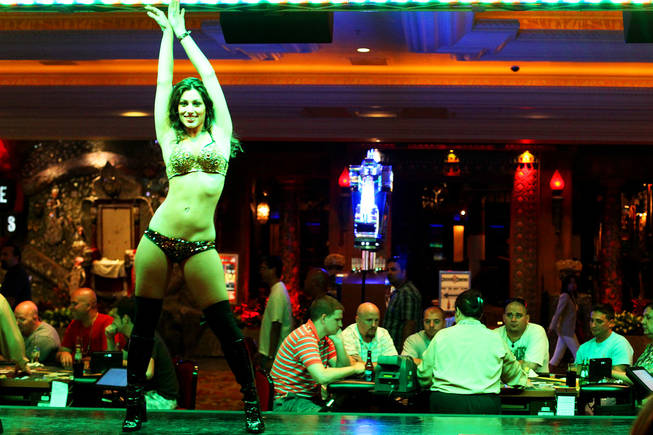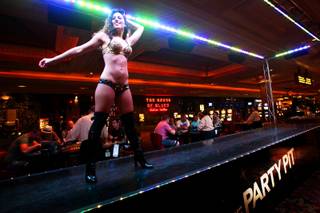
Krystle Lehr entertains gamblers Friday, Aug. 20, 2010, at Mandalay Bay’s “Party Pit” blackjack table area.
Thursday, Aug. 26, 2010 | 2 a.m.
Reader poll
Sun Coverage
Sun Archives
Few things raise the hackles of loyal blackjack fans more quickly than casinos cutting back on what they pay gamblers for hitting 21.
But an increasing number of casinos are quietly doing that, reducing blackjack payouts by 20 percent.
One reason: The casino has to pay for that pretty woman dancing on the little stage in the blackjack pit.
Welcome to the next generation of blackjack player, the trendy younger crowd that wants to play cards in “party pits,” where the furniture has been rearranged to accommodate dancers. And some casinos are saying their costs are on the rise for other various reasons. In either case, casinos are reducing their blackjack payouts from 3:2 (meaning a winner gets $3 for each $2 bet) to 6:5 (winning $6 on a $5 bet).
Do the math: That’s a 20 percent reduction on the payout. For every dollar wagered, the winning blackjack player will get $1.20 instead of $1.50. Or you can skip the math and look at the woman on stage.
Old-timers may be incredulous that casino floor managers are getting more tightfisted with payouts, and take their business to better-paying casinos. But more casual players might not notice, or understand the significance, that some tables are paying out at 6:5. You can find the odds printed on the table felt. Or, hey, you can check out those dancers.
Dennis Conrad, president and chief strategist of the Reno-based Raving Consulting Co., sees both sides of the issue.
“When I first looked at it from a marketing standpoint, I thought it was a horrible idea,” Conrad said of decisions to change blackjack payment rules.
But Conrad said he’s not insensitive to increased labor costs, the cost of comping guests and the expense of new marketing concepts to attract younger gamblers.
On the other hand, he points out, the more favorable payouts for players will keep them playing longer, which benefits casinos in the long run.
“An alternative for the casino is to take some other expense away,” Conrad said. “So what do you do, do you eliminate comps or quit serving drinks?”
Many casinos are deciding that changing the payout formula is the least painful alternative.
The formula change comes as casinos are discovering how younger players want to spend their gambling money. Conventional wisdom has been that young players would gravitate to slot machines because of their skill and experience with video games. But more and more, Conrad said, the social interaction of the experience is drawing younger players to tables — especially in the party pits or those that use “dealertainers,” dealers who also entertain as celebrity impersonators.
The party pit at Mandalay Bay has brought more energy to the floor, said Rick Fields, vice president of casino operations.
“And it makes money every weekend. Our bar revenue there is 12 percent higher than other bars, and we have higher slot revenue in that area.”
Mark Gore, former general manager of the Hard Rock casino, saw similar successes with Hell’s Belles, dancers who perform in the blackjack pit.
The Hard Rock advertises the pit as a place where players can “test your blackjack skills while mingling with some of the hottest women in the world.”
The concept produces the best of all worlds for the Hard Rock — table minimums are $25 and often climb to $100 when demand is high, automatic shuffling machines keep the games moving quickly and players tend to stay longer to admire the eye candy. And the tables pay 6:5.
Gore said the company had to invest in a 25-foot stage and three poles for the dancers. After the first year, the drop, or money wagered and lost, at those tables was up 85 percent over the previous year, and in the second year, it was up 45 percent over that.
Anthony Curtis, who publishes the Las Vegas Advisor, is skeptical that the 6:5 payouts were introduced to offset rising costs.
“It was something they did because they knew they could get away with it,” Curtis said. “It’s all about what the market will bear.”
Curtis said most blackjack novices don’t even realize the casino is getting a greater advantage with 6:5.
“It’s a 1.4 percent difference in the house advantage and that’s huge,” Curtis said. “I don’t think anybody has seen any of their traffic drop off. People won’t go to another casino just to find a table that pays 3:2. But there are very few single-deck 3:2 tables anymore because customers did not rise up when this got started. There’s a vocal minority out there that you hear all the time, talking about how ‘the man’ is taking down tourists.”
CORRECTION: This story has been corrected to reflect that the change in the payoff formula from 3:2 to 6:5 is a 20 percent reduction. | (August 26, 2010)



Join the Discussion:
Check this out for a full explanation of our conversion to the LiveFyre commenting system and instructions on how to sign up for an account.
Full comments policy